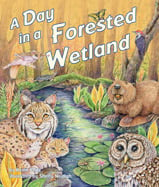Alignment to Standards for MD

| Grade | Number | Standard |
|---|---|---|
| 1 | SC-1.3.0.A.1. | Compare and explain how external features of plants and animals help them survive in different environments. |
| 1 | SC-1.3.0.A.1.b | Compare similar features in some animals and plants and explain how each of these enables the organism to satisfy basic needs. |
| 1 | SC-1.3.0.A.1.c | an organisms external features contribute to its ability to survive in an environment. |
| 1 | SC-1.3.0.E.1.a | Examine organisms in a wide variety of environments to gather information on how animals satisfy their need for food. |
| 1 | SS-1.3.0.B.1.a | Identify and describe physical characteristics of a place (physical features, climate, vegetation and animal life) |
| 2 | SC-2.3.0.F.1. | Explain that organisms can grow and survive in many very different habitats. |
| 2 | SC-2.3.0.F.1.a | Investigate a variety of familiar and unfamiliar habitats and describe how animals and plants found there maintain their lives and survive to reproduce. |
| 2 | SC-2.3.0.F.1.b | Explain that organisms live in habitats that provide their basic needs: Food, Water, Air, Shelter |
| 2 | SS-2.3.0.B.1. | Classify places and regions in an environment using geographic characteristics |
| 2 | SS-2.3.0.B.1.b | Describe and classify regions using climate, vegetation, animal life, and natural/physical features |
| 3 | SS-3.3.0.B.1.a | Compare places and regions using geographic features |
| 4 | SC-4.3.0.A.1. | Explain how animals and plants can be grouped according to observable features. |
| 4 | SC-4.3.0.A.1.a | a variety of animals or plants in both familiar and unfamiliar environments. |
| 4 | SC-4.3.0.A.1.b | Classify a variety of animals and plants according to their observable features and provide reasons for placing them into different groups. |
| 4 | SC-4.3.0.A.1.c | Given a list of additional animals or plants, decide whether or not they could be placed within the established groups or does a new group have to be added. |
| 4 | SC-4.3.0.A.1.d | Describe what classifying tells us about the relatedness among the animals or plants placed within any group. |
| 4 | SC-4.3.0.D.1.a | Describe ways in which organisms in one habitat differ from those in another habitat and consider how these differences help them survive and reproduce. |
| 4 | SC-4.3.0.D.1.b | Explain that the characteristics of an organism affect its ability to survive and reproduce. |
| 4 | SC-4.3.0.F.1.a | Explain ways that individuals and groups of organisms interact with each other and their environment. |
| 4 | SC-4.3.0.F.1b | Identify and describe the interactions of organisms present in a habitat: Competition for space, food, and water |
| 4 | SC-4.3.0.F.1c | Identify and describe the interactions of organisms present in a habitat: Beneficial interactions: nesting, pollination, seed dispersal, oysters filtering as in the Chesapeake Bay, etc. |
| 5 | SC-5.3.0.A.1. | Explain the idea that in any particular environment, some kinds of plants and animals survive well, some less well, and some cannot survive at all. |
| 5 | SC-5.3.0.E.1. | Recognize that some source of energy is needed for all organisms to grow and survive. |
| 5 | SC-5.3.0.E.1.d | some insects and various other organisms depend on dead plant and animal material for food. |
| K | SC-K.3.0.A.1.d | Compare ideas about how the features of animals and plants affect what these animals are able to do. |
| K | SC-K.3.0.D.1. | living things are found almost everywhere in the world and that there are somewhat different kinds of living things in different places. |
| K | SC-K.3.0.D.1.b | describe and compare living things found in other states such as Texas and Alaska to those found in Maryland. |
| K | SC-K.3.0.D.1.c | Explain that the external features of plants and animals affect how well they thrive in different kinds of places. |
| K | SC-K.3.0.E.1.a | Make observations of the features and behaviors of many different kinds of animals within an environment to identify and begin building a list of some of the basic needs these organisms share, such as water, air, etc. |
| K | SC-K.3.0.F.1.a | Describe observations of the place and some of the living things found there. |
| K | SC-K.3.0.F.1.c | Describe ways that animals and plants found in each place interact with each other and with their environment. |
| K | SC-K.6.0.B.1.b | Identify features of the natural environment that are not made by humans. |
| K | SS-K-3.0.B.1.a | Recognize physical features as landforms and bodies of water using photographs and pictures |
| K | SS-K-3.0.B.1.b | Identify land forms, such as mountains and hills, and bodies of water, such as oceans, rivers, and streams |
| PK | SC-PK.3.0.A.1. | familiar plants and animals to describe how they are alike and how they are different. |
| PK | SC-PK.3.0.A.1.d | Identify some of the things that all animals do, such as eat, move around and explain how their features (observable parts) help them do these things. |
| PK | SS-PK-3.0.B.1.e | Discuss that places have natural/physical features such as mountains, rivers, and hills |